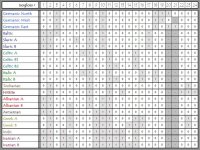Beat a dead horse indeed. The irony.
I think the model above might help some people understand.
And I encourage everyone to consider horses more scrupulously. Domesticated ones.
*EDIT*
It occurred to me that I should comment on the wave model I posted. This is an oldy, but a goody. I think it was published in 1972. Here you see 24 Isoglosses, and 1 is Centum/Satem. Some of these are only relevant to subfamilies, but it's still a baller chart. In spite of Centum/Satem you see that Greek-Irainian/Indic-Armenian share many similarities as do Germanic-Baltic-Slavic and even Celtic-Italic-Tocharian-Hittite. Of particular interest to this discussion would be Tocharian and Hittite/Anatolian. Both very conservative, very similar to each other, and yet about as far apart as possible. This means that both of these languages departed from the PIE seat very early, retaining archaisms. Especially Hittite. In Hittite we even see a lack of forms that developed in ALL other IE languages indicating that it was likely the first departure. In fact it may have left before PIE even became the PIE whence all other IE languages came from. This sort of rules out an Anatolian homeland, on a purely linguistic geographic basis.
Given some of the similarities we see my guess is that Italic/Celtic, Hittite, and Tocharian were early departures forming the initial periphery. Latter departures were Greek/Armenian and Indo-Iranian, and Baltic/Slavic-Germanic form the center of gravity that didn't move all that much. The similarities between Germanic and Celtic are likely from latter interactions, which fit the archaeological and historical record perfectly.
BUT, if one flips things, which given the strangeness of the archaeology and culture of the Hittites isn’t too crazy, we could reverse it and propose that “Proto-Hittite” is actually the real PIE that the cattle herders brought to the steppe through the Caucuses. I believe this is what the R1b cattle driver theorists would need to stand on. This sounds like a brilliant reversal, but makes explaining latter IE expansions, and how they arrived at their historical seats nearly impossible. Unless we say that the “cattle breeding R1bs” infiltrated the steppe through the caucuses, enveloping the steppe peoples and converting them to their pastoralist culture and language while leaving remnants of the true PIE back home in Anatolia. Such a model teeters on the edge of exceeding the scope of the homeland problem, and I would probably have to argue that the PIE homeland would still be the Pontic-Steppe on the basis that expansions would still need to have begun there. I think this is, if not impossible, extremely unlikely on countless other grounds, but an interesting idea. PIE would have been surrounded by non IE languages which it no doubt would have shared much more similarities with; Hattic, Hurrian, Semitic, etc. just before teleporting across the caucuses to found PIE version 2 – Horses and hunters. There are also a ton of Hurrian and Hattic loanwords in Hittite. Why don’t we see at least some of these in PIE? If the true PIE is really a sort of proto-Hittite, then it would probably extend deep into the Neolithic. So we would not only have expected form similarities along with word sharing by the Early Bronze age, but also expected to see a deeply rooted agricultural lexicon easily reconstructed to PIE.
PIE from Anatolian R1b cattle drivers moving from their Anatolian homeland not only doesn’t fit, but it’s an answer to a different question. PIE is a Bronze age language, and if we push theories too far back we’re talking about something that couldn’t be PIE in the first place.
Here's another chart showing distance between languages through ascribing a binary structure to the isoglosses: 0->1 for innovation or change.


